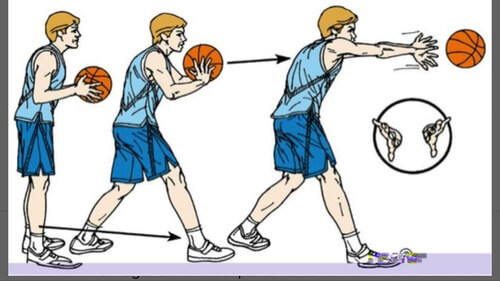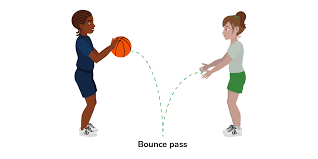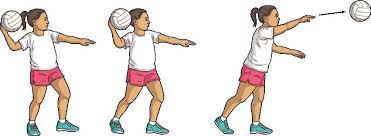Netball is one of the most exciting sports in the world and it’s full of different types of passes in netball. It is also great if you are learning any other ball sport. If you are interested then you need to know the types of passes in netball.
[toc]
15 Types Of Passes In Netball That You Might Not Know
Netball is a ball sport played mainly by women. It evolved from early versions of basketball and association football. The first netball game appeared in 1895 in England. Nowadays netball is played at local, national, and international levels by many countries around the world.
Its rules are similar to these other sports, with some exceptions including the use of an oval-shaped ball, not the round-shaped one used in American high school and college games while also being much less physically demanding than either sport.
Let’s look at the types of passes in netball:
1. Chest Pass
Player A scoops the ball up in their dominant hand and passes it diagonally across their body to player B. The pass should be right on the chest, with the elbows pointing outwards. This pass works well for long and short distances.
To practice this pass two-player stand about 2m apart facing each other. Player A runs with the ball as if they are going to pass to player B, at the last moment player A passes it across their chest diagonally to player B. The aim is to pass with more accuracy than speed.

2. Bounce Pass
Player A runs forward with the ball and bounces it at their feet 3 times before passing to player B. This type of pass is often used for short-distance passes.
To practice this pass one or two players stand about 3 metres apart facing each other, player A runs with the ball bouncing it once on the floor then twice on their knees then once more on the floor, and lastly, right before reaching player B, then player A bounces it again with their dominant hand then passes to player B. The aim is to pass accurately with speed.

3. Overhead Pass
Player A runs forward with the ball slightly in front of them like they are going to run past player B without passing it to them, then player A tosses the ball slightly up in front of them and passes it to player B. This is often used for long-distance passes because the ball goes over any opponents’ heads.
To practice this pass one or two players stand about 5m apart facing each other, player A runs with the ball bouncing it once on their knees then twice on their chest then once more on their knee, and lastly, right before reaching player B, then player A bounces it again with their dominant hand then passes to player B. The aim is to pass accurately with speed.

4. Side Pass
Player A runs forward with the ball in front of them like they are going to run past player B whilst keeping the ball visible to them, then player A passes the ball to their dominant side without knocking it out of their reach.
To practice this pass one or two players stand about 5m apart facing each other, player A runs with the ball bouncing it once on their knee then twice on their chest then once more on their knee, and lastly, right before reaching player B, player A passes the ball to their dominant side without knocking it out of their reach. The aim is to pass accurately with speed.
5. Flick Pass
Player A runs forward with the ball in front of them like they are going to run past player B whilst keeping the ball visible to them, then player A flicks or taps it into their other hand and passes it to player B. This pass is often used for close-range passes because the ball goes over any opponents’ heads.
To practice this pass one or two players stand about 2m apart facing each other, player A runs with the ball bouncing it once on their knee then twice on their chest then once more on their knee, and lastly, right before reaching player B, player A flicks the ball into their other hand and passes it to player B. The aim is to pass accurately with speed.
6. Backwards Pass
Player A runs forward with the ball in front of them like they are going to run past player B whilst keeping the ball visible to them, then player A passes the ball behind themselves to get it into their other hand and uses that hand to pass it back around to player B. This pass is often used for close-range passes because it goes over any opponents’ heads.
To practice this pass one or two players stand about 2m apart facing each other, player A runs with the ball bouncing it once on their knee then twice on their chest then once more on their knee, and lastly, right before reaching player B, then player A passes the ball behind themselves to get it into their other hand and uses that hand to pass it back around to player B. The aim is to pass accurately with speed.
7. Fake Pass (Side)
Player A runs forward with the ball and pretends to pass it sideways, then passes it in front or behind themselves when they get to player B. This pass is often used for close-range passes because it goes over any opponents’ heads.
To practice this pass one or two players stand about 2m apart facing each other, player A runs with the ball bouncing it once on their knee then twice on their chest then once more on their knee, and lastly, right before reaching player B, player A pretends to pass it side, then passes the ball in front or behind themselves when they get to player B. The aim is to pass accurately with speed.
8. Fake Pass (Front)
Player A runs forward with the ball and pretends to pass it in front of themselves, then passes it behind themselves when they get to player B. This pass is often used for close-range passes because it goes over any opponents’ heads. The aim is to pass accurately with speed.
To practice this pass one or two players stand about 2m apart facing each other, player A runs with the ball bouncing it once on their knee then twice on their chest then once more on their knee, and lastly, right before reaching player B, player A pretends to pass the ball in front of themselves, then passes it behind themselves when they get to player B.
9. Cross Pass
Player A runs forward with the ball keeping it visible to them and bounces it twice on their knee then once more on their chest then once more on their knee before crossing over to the other side of player B. Player A passes the ball across their body to player B, who now has visibility of the ball. This pass is often used for close-range passes because it goes over any opponents’ heads.
To practice, this pass one or two players stand about 2m apart facing each other, player A runs with the ball bouncing it once on their knee then twice on their chest then once more on their knee, and lastly, crossing over to the other side of player B. Player A passes the ball across their body to player B, who now has visibility of the ball. The aim is to pass accurately and smoothly.
10. Lob Pass
Player A runs forward with the ball keeping it visible to them and bounces it twice on their knee then once more on their chest then lastly, right before reaching player B, player A flicks the ball into their other hand and lobs it over the player B’s head to them. This pass is often used for long passes because both players have visibility of the ball.
To practice this pass one or two players stand about 2m apart facing each other, player A runs with the ball bouncing it once on their knee then twice on their chest then lastly, right before reaching player B, player A flicks the ball into their other hand and lobs it over player B’s head to them. The aim is to pass accurately and smoothly.
11. Punch Pass
Player A runs forward with the ball and holds it close to their chest then just before reaching player B, player A punches the ball into their other hand and passes it over player B’s head to them. This pass is often used for long passes because both players have visibility of the ball.
To practice this pass one or two players stand about 2m apart facing each other, player A runs with the ball and holds it close to their chest then just before reaching player B, player A punches the ball into their other hand and passes it over player B’s head to them. The aim is to be accurate and to pass it over player B’s head.
12. Shoulder Pass
Player A runs forward with the ball and holds it high up under their chin then just before reaching player B, player A passes the ball over their shoulder to player B. This pass is often used for long passes because both players have visibility of the ball.
To practice this pass one or two players stand about 2m apart facing each other, player A runs with the ball and holds it up under their chin then just before reaching player B, player A passes the ball over their shoulder to player B. The aim is to be accurate and to pass it over player B’s head.
13. Pivot Pass
Player A runs forward with the ball, keeps it visible but does not bounce the ball. Then just before reaching player B, player A turns to face the opposite direction of where they are running and passes the ball over their head to player B. This pass is often used for long passes because both players have visibility of the ball.
To practice this pass one or two players stand about 2m apart facing each other, player A runs with the ball keeping it visible but does not bounce the ball. Then just before reaching player B, player A turns to face the opposite direction of where they are running and passes the ball over their head to player B. The aim is to pass accurately and smoothly.
14. Free Pass
In netball, a player without a ball cannot move into an area other than their designated place. If they do, the opposing party gets a free pass.
15. One-Handed Or Two-Handed Passes
A one-handed pass is where player A with the ball in their dominant hand passes it into their other hand before passing it to player B, this would be considered a one-handed pass. If they with the same hand that they are holding with, then it would be called a two-handed pass.
To practice these passes one or two players stand about 2m apart facing each other, player A with the ball in their dominant hand passes it into their other hand before passing it to player B. The aim is to pass accurately and smoothly.
Types Of Passes In Netball – Conclusion
Netball passes are used to maintain the game and make sure it runs smoothly. There are many different types of passes that can be used in netball, each one having its ways of being executed. Some passes can be faked to confuse opponents while others are simply passed quickly to another player.
Passes that keep the ball visible to both players are important to maintaining the game because if one player doesn’t have visibility of the ball then they can’t execute a pass. Passes that are accurate need to be executed carefully, making sure that the ball is passed accurately over the other player’s head.